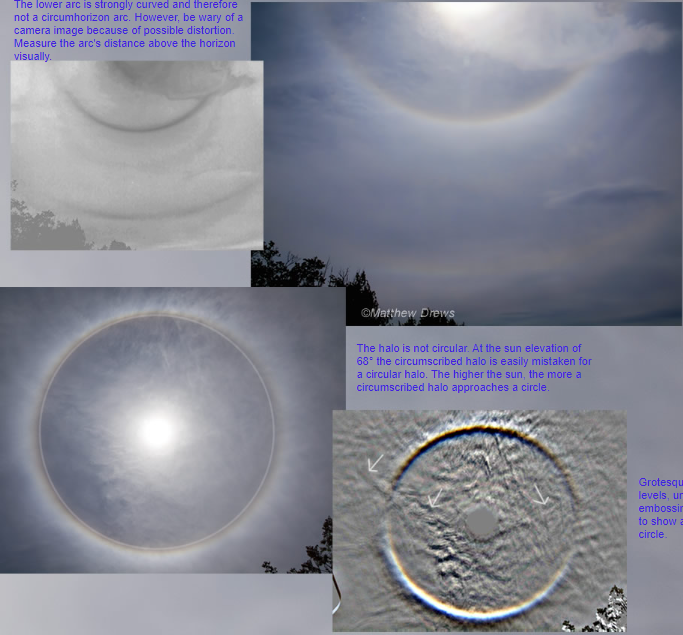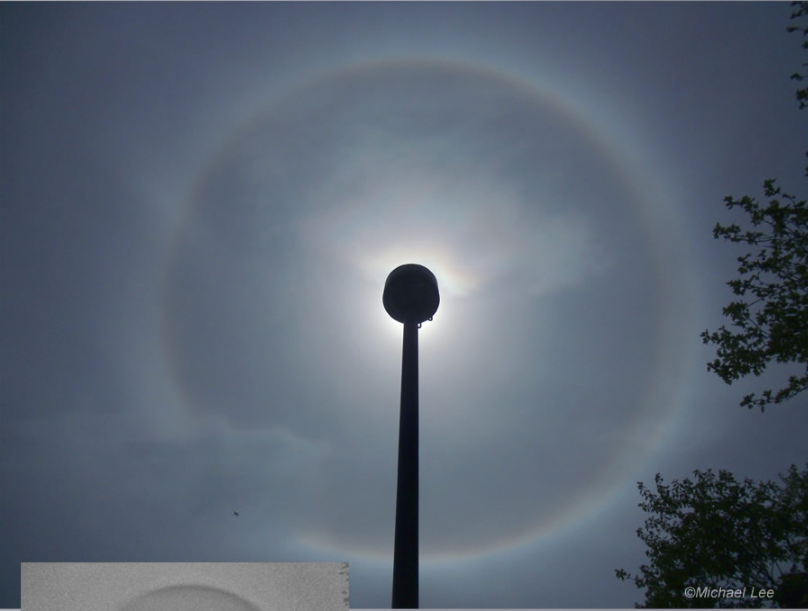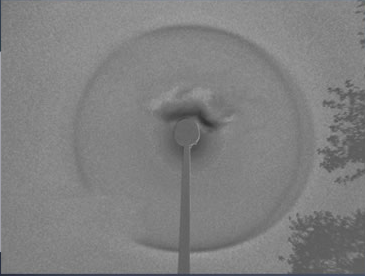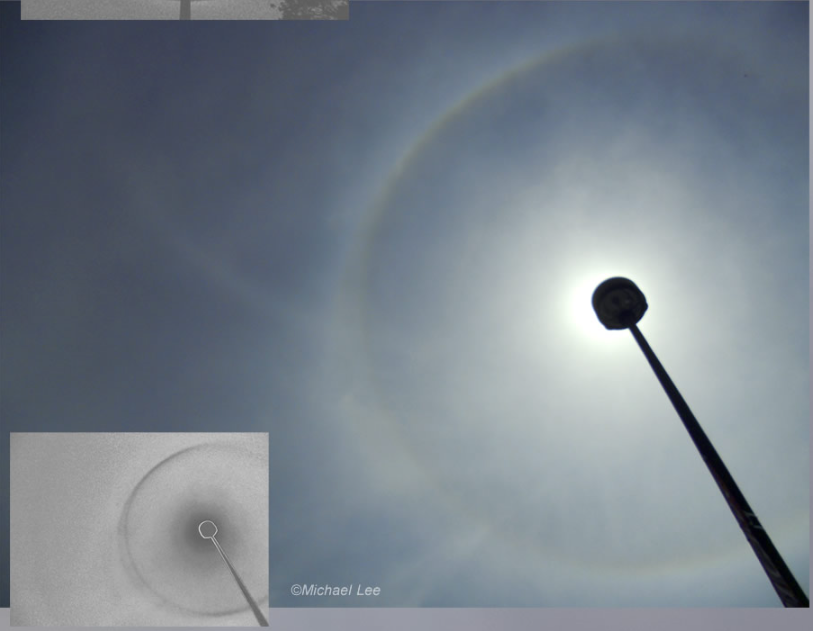OPOD - New Jersey Halos
OPOD - New Jersey Halos: A Spectacular Display of Atmospheric Optics
Ice halo displays can create breathtaking optical phenomena in the sky, and on May 14, 2013, Matthew Drews witnessed a remarkable event in New Brunswick, New Jersey. The US east coast experienced extensive halo displays that day, capturing the attention of sky enthusiasts and photographers alike.
One of the most prominent features of this display was a bright circular halo that persisted for several hours. This halo, encircling the sun, is known as a 22° halo and is formed by randomly oriented hexagonal ice crystals. Its circular appearance can be deceiving, as there were other intriguing halos present in the sky that day.
Just below the sun and close to the horizon, there was a faint yet massive colorful halo. This halo appeared to curve strongly upwards from the horizon, making it unlikely to be a circumhorizon arc, which typically remains parallel to the horizon. The curvature of this halo was captured in enhanced images, although caution was advised due to potential camera distortions.
One possible explanation for this curved halo is an infralateral arc, formed by horizontal column crystals. However, if this were the case, there should also be an oval inner halo around the sun called a circumscribed halo. Comparing the images with an added circle confirmed the presence of an oval inner halo. Additionally, severe enhancement revealed a faint high sun parhelic circle, further adding to the complexity of this atmospheric display.
The plot thickens when we examine a lower arc that exhibits strong curvature. This arc, again not a circumhorizon arc due to its curvature, required careful measurement of its distance above the horizon to rule out any camera distortions. As the sun's elevation increased, the circumscribed halo approached a circular shape, making it easy to mistake for a regular 22° halo.
As the day progressed, Michael Lee captured images of the display from a location near Matthew Drews. These images, taken at a lower sun elevation, showcased the changing sky. The circumscribed halo became more oval, with the 22° halo appearing inside it. A hint of cloud iridescence near the sun added another layer of visual interest.
At lower sun altitudes, any infralateral or circumhorizon arcs would have faded, as the rays forming them would be increasingly internally reflected within the ice crystals. Distinguishing between the 22° halo and circumscribed halos becomes more challenging when the sun is high. Multiple images and accurate camera clock synchronization are crucial to properly document and analyze these phenomena.
Observing the characteristics of the halos can provide valuable insights. The circumscribed halo tends to have more saturated colors and tapers off more sharply away from the sun. A color separation technique can highlight the circumscribed halo and inner 22° halo, while the parhelic circle disappears as it lacks color.
The New Jersey halo display serves as a captivating example of atmospheric optics. These intricate phenomena result from the interaction of sunlight with ice crystals suspended in the atmosphere. Understanding their formation requires careful observation, documentation, and analysis. So, next time you find yourself gazing at the sky, keep an eye out for these fascinating halos and immerse yourself in the wonders of atmospheric optics.

What was it?
Matthew Drews saw this ice halo display in New Brunswick, New Jersey May 14,2013. The US east coast had extensive halo displays that day.
At top: is a bright circular halo that persisted for several hours.
The lower image shows a faint but huge colourful halo beneath the sun and close to the horizon.
What are they?
The first reaction to a halo circling the sun is that it is a 22° halo produced from randomly oriented hexagonal ice crystals. It looks circular doesn't it? The large halo beneath the sun might then be a rare 46° halo fragment (improbable) or a circumhorizon arc from plate crystals.
However, the lower halo appears to curve up strongly from the horizon making it less likely to be a circumhorizon arc which is always parallel to the horizon. The enhanced view (below) shows the curvature. But beware of camera distortions - it could be a circumscribed halo!
An infralateral arc from horizontal column crystals curves upwards. But in that event, there ishould be an oval inner halo around the sun - a circumscribed halo generated by rays through the same crystals. There could also be a superimposed circular 22° halo.
Comparison with an added circle (below left) shows that the inner halo was in fact oval (to the extent one believes a camera lens without star field calibration) and severe enhancement shows a faint high sun parhelic circle. A HaloSim ray tracing for the solar elevation of 68° gives weight to the interpretation....
... A circumscribed halo, probably an infralateral arc, a parhelic circle from horizontal column crystal and possibly also a 22° halo.
But then the plot thickens.. .. see below.

The lower arc is strongly curved and therefore not a circumhorizon arc. However, be wary of a camera image because of possible distortion. Measure the arc's distance above the horizon visually.
The halo is not circular. At the sun elevation of 68° the circumscribed halo is easily mistaken for a circular halo. The higher the sun, the more a circumscribed halo approaches a circle.
Grotesque enhancement - levels, unsharp mask, embossing - just manages to show a high-sun parhelic circle.

The topmost image was taken at 12:55 EDT with the sun was 68° high.
Later on - and coincidentally - Michael Lee took images of the display from within a mile of Matthew Drews' position. These images became available after the above analysis.
How the sky changes! At left is the scene at ~14:15 - 14:30 with the sun now lower at 62-59°.
The circumscribed halo has become more oval and inside it is the 22° halo. Perhaps there is a trace of cloud iridescence near the sun.
The lower image clearly shows a parhelic circle.
At these lower sun altitudes any infralateral or circumhorizon arcs would be fading fast as the rays forming them would be increasingly internally reflected within the crystals.
When the sun is high the 22° halo and circumscribed halos are not easy to tell apart. Take plenty of images and be sure that the camera clock is accurate. Keep the image EXIF data.
Look for a hint of two halos at 3 and 9 o'clock from the sun. Look for brightening at 12 and 6 o'clock.
The circumscribed halo tends to have more saturated colours and tapers off more sharply away from the sun.

A colour separation technique clearly highlights the circumscribed halo and inner 22° halo. The parhelic circle disappears because it has no colour.

A clear parhelic circle.
Note: this article has been automatically converted from the old site and may not appear as intended. You can find the original article here.
Reference Atmospheric Optics
If you use any of the definitions, information, or data presented on Atmospheric Optics, please copy the link or reference below to properly credit us as the reference source. Thank you!
-
<a href="https://atoptics.co.uk/blog/opod-new-jersey-halos/">OPOD - New Jersey Halos</a>
-
"OPOD - New Jersey Halos". Atmospheric Optics. Accessed on November 26, 2024. https://atoptics.co.uk/blog/opod-new-jersey-halos/.
-
"OPOD - New Jersey Halos". Atmospheric Optics, https://atoptics.co.uk/blog/opod-new-jersey-halos/. Accessed 26 November, 2024
-
OPOD - New Jersey Halos. Atmospheric Optics. Retrieved from https://atoptics.co.uk/blog/opod-new-jersey-halos/.